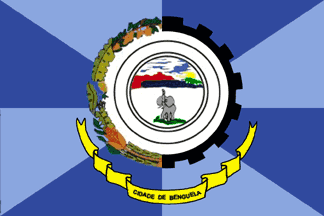be.jpg) scan by
Bruce Berry, 20 July 2008
scan by
Bruce Berry, 20 July 2008
Last modified: 2014-04-14 by bruce berry
Keywords: national index | angola |
Links: FOTW homepage |
search |
disclaimer and copyright |
write us |
mirrors
 Image
by Jens Pattke, 09 March 2014
See also:
Image
by Jens Pattke, 09 March 2014
See also:
"Benguela (Săo Felipe de Benguela, formerly spelled Benguella) is a city in
western Angola, south of Luanda, and capital of Benguela Province. It lies on a
bay on the Atlantic Ocean of the same name.
Benguela was founded in 1617 by the Portuguese under Manuel Cerveira Pereira,
8th Governor of Angola (1604-1607). It was long the centre of an important
trade, especially in slaves to Brazil and Cuba. Ships have to anchor about a mile off
the shore, in 4 to 6 fathoms (7 to 11 m) and transfer loads to smaller boats
which use five or six jetties in the town. However, the nearby deep-water
sheltered harbour of Lobito is a much larger port.
Benguela is Angola's second most famous city and self-appointed cultural capital.
It
is a charming muddle of low-rise apartment blocks and sputtering motorcycles
that weave deftly between Benguela's famous crimson acacia trees.
The Benguela Railway was built in the early 20th century to connect the city and
Lobito to the interior, and it achieved great success when it was linked to the Copperbelt of Katanga
(in the DR Congo) and Zambia. Due to the civil war in Angola which followed
independence in 1975 and last until 2001, this railway is no longer operating. Only the short distance of 30 km between Benguela and Lobito remains
operational. In the last two years, rehabilitation of the railway between
Benguela and Huambo has commenced.
In 1983 Benguela had a population of 155,000. During the civil war the city of
Benguela increased its population due to refugees from the countryside. While
the colonial part of the city consists of relatively good quality houses, most
of the refugees are living today in slum areas." - from
Wikipedia.
The city flag is shown on a photo here
:<http://www.skyscrapercity.com/showthread.php?t=601552> and
again at :<http://img529.imageshack.us/img529/8462/ben2kk2.jpg>.
Valentin Poposki, 12 July 2008
The municipal flag has the municipal badge (or Arms) in the centre with a
background of blue and white in the typical Portuguese gyronny pattern .
Ron Lahav, 12 July 2008
The background of the flag isn't blue and white; it's sky blue and medium
blue.
This is an Angolan flag, not a Portuguese one. While it does follow the
Portuguese vexillological tradition with the gyronny pattern, I suspect it's a
purely Angolan creation (or perhaps evolution from a
previous colonial Portuguese flag), because Portuguese flags would hardly be
allowed with such un-heraldic choice of colours.
The symbol in the centre also does not follow in the traditional Portuguese
heraldic tradition and appears to be a purely Angolan, despite having some
continuity from the Portuguese arms of the city which was a silver elephant on a
gold background (see
Wikipedia).
The words in the scroll (inverted in the photo) reads "CIDADE DE BENGUELA",
i.e., "City of Benguela".
Jorge Candeias,
17 July 2008
be.jpg) scan by
Bruce Berry, 20 July 2008
scan by
Bruce Berry, 20 July 2008
This stamp from pre-independence Angola shows the municipal arms of Benguela
with a shield comprising a red elephant against a gold background which is
different from that shown on Wikipedia as indicated by Jorge above.
Bruce Berry, 20 July 2008
It is common that Portuguese civic flag backgrounds are taken from the the
field and charges of the shield of the municipal, but I'd add a few comments:
Only basic colours and metals are used: No regular flag in the Portuguese civic
heraldic/vexillological system has a background, gyronny or quarter filled with
any other such pattern, which appear also relatively seldom in the shields.
I also note that solid black flag backgrounds, while apparently acceptable, seem
never to have been used in Portuguese civic heraldic/vexillological
system.
António MARTINS-Tuválkin, 27 July 2008